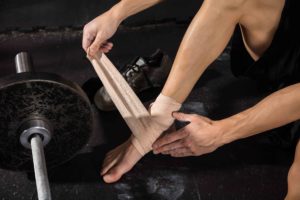Tendons

Tendons attach muscle to bone, and are primarily found near joints. When you contract your muscles, those muscles pull on the tendons which are attached to bone, resulting in movement of the bone at the joint.
In addition, your tendons have elastic properties. This means that when you perform plyometric or repetitive-type tasks like jumping and running, the tendons function somewhat like a spring where they store some of the energy and then release it upon the upward bound.
Tendon Stressors
There are normal and abnormal stressors that result in different outcomes on tendons. Because tendons attach directly to muscle, they too are stressed during activities that contract or stretch that muscle.
Tendons experience particular stress during repetitive activity.
The way by which tendons adapt to stressors is dependent on the nature of the stressor, as well as the recovery process post stressor.
Please remember, challenging obstacles from which you are able to fully recover result in a good stress known as Eustress. On the other hand, obstacles deemed threatening and/or obstacles from which you are unable to fully recover will result in a negative stress known as Distress.
Distress: A Dangerous Threat to Tendons
Negative and potentially painful stress may occur when stressors placed on a tendon exceed that of what the tendon can handle. Inappropriate loading and stress consisting of excessive and repetitive muscular/tendon contraction and/or overstretching of the tendon may result in tendon injury
In addition, short term changes in daily tendon stress, whether increased or decreased, also increases the risk of tendon injury.
There are 3 primary grades of tendon injury, which are accompanied by the following signs and symptoms:
Grade 1 (first-degree) tear
- Microtearing of the tendon
- Mild pain that begins within the first 24 hours post injury
- Mild swelling
- Local tenderness with palpation/touch
- Pain reproduced when the involved tendon is stretched or contracted
Grade 2 (second-degree) tear
- Mild-moderate tearing of the tendon (partial tear)
- Moderate pain that requires stopping the activity
- Mild-moderate swelling
- Significant increase in pain with palpation/touch
- Significant increase in pain when the involved tendon is stretched or contracted
Grade 3 (third-degree) tear
- Near complete or complete tear
- Severe pain
- Moderate-severe swelling
- May notice a defect with palpation
- Stressing tendon may be painless
Resolve What's Holding You Back: Restoration and Recovery
Upon injury and distress, tendons undergo a process of healing consisting of the Inflammatory phase, Proliferation phase, and Remodeling phase.
Please read the following article to understand how best to manage your tendon injury during each of the 3 phases of healing.
Eustress: A Healthy Challenge for Tendons
Tendons are stressed and loaded appropriately when they, along with the muscles they are attached to, contract against a resistance and/or are stretched within the limits of what the tendon can handle.
Tendons are loaded and stressed often throughout the day with everyday activities that involve movement of your body. With proper loading, tendon strength and/or length will either remain the same or increase depending on your activity level.
Time to Move Forward: Preparation and Fitness
Improving fitness is among the most effective approaches addressing the ‘preparation’ aspect of performance enhancement. Preparing for maximal performance through fitness involves optimizing the balance between movement quality, strength, endurance, and speed.
Focusing on movement quality ensures that you are not placing excessive stress onto unintended muscles and tendons while not properly utilizing the intended muscles and tendons. Improper movement quality may lead to an imbalance where the over-stressed tendons experience pain and injury, while the under-utilized tendons lack the benefits from exercise and fitness resulting in reduced overall performance.
Focusing on strength prepares your tendons to handle greater loads and stress, and ultimately become more resilient to injury.
Focusing on endurance improves blood flow and nutrition to your tendons.
Focusing on speed improves how well your tendons are able to adapt to fast movement and activity. In addition, speed training may improve the elastic nature and performance of your tendons.
TAKE ACTION!
- If you believe you have undergone a tendon-related injury, be sure to consult with a licensed healthcare provider specializing in this field in order to receive a definitive diagnosis rather than attempting to “guess and test.”
- Please make sure you clearly understand the 3 phases of healing. I am always available if you have any questions.
- As you enter the proliferation and remodeling phases of healing, initially focus your efforts on developing movement control through muscular activation in ways that reduce stress onto the affected tendon. As you progress through heeling, you will gradually re-introduce activities that contract and stretch the affected tendon in a way that may reproduce symptoms but does not result in lingering aggravation.
- It is time to begin the ‘preparation’ aspect of performance enhancement as soon as sufficient restoration of any tendon-related distress has occurred. When ready, begin implementing the information presented in this article, as well as the remainder of the content within the “Convergent Path to Performance,” in order to maximize Eustress while minimizing Distress.
Summary
Tendons play a significant role within your body, and undergo a multitude of stressors throughout the day. The key is to remember that you hold massive influence over the health of your tendons. By understanding how tendons are stressed and recover, you will have the tools necessary to maximize positive adaptation while reducing the occurrence of distress and injury.

Dr. Eugene Ketselman PT, DPT, Cert. MDT, CSCS
Dr. Eugene Ketselman is a licensed Physical Therapist, Certified Strength and Conditioning Specialist, Performance Coach, and owner of Convergent Movement and Performance; Home of where Physical Therapy, fitness, and performance training converge! Dr. Ketselman's mission is to help motivated athletes and active adults excel in their passions by maximizing physical performance and reducing setbacks from pain and injury.
Here at Convergent Movement and Performance, we practice what we preach. You know we are a good match for one another as soon as you find yourself relating to the content we provide. Be sure to click below to learn more.
Do you have specific questions that aren’t answered on this website?
Click below
Does pain, weakness, or exhaustion prevent you from reaching your FULL potential while performing the activities you love?
Click below
Do you love what you’re seeing, but still aren’t sure if you can make the commitment?
Click below
Contact Us
Convergent Movement and Performance serves out of Northern – Central New Jersey, conveniently located to those that live, work, and travel in the nearby towns of Warren, Bridgewater, Martinsville, Watchung Hills, Bedminster, Basking Ridge, Bernardsville, Chatham, Westfield, and Piscataway within Somerset, Morris, Union, and Middlesex counties, NJ.

